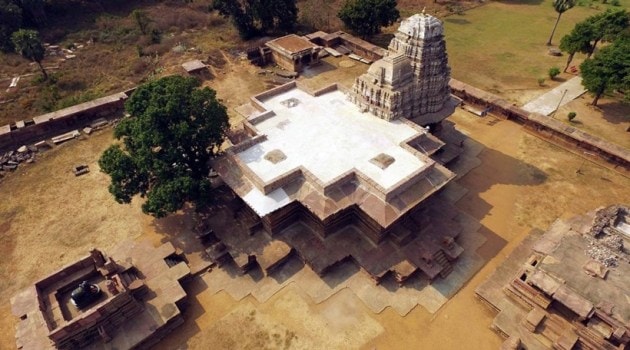Before Ramappa Temple, these Indian monuments and places became UNESCO World Heritage sites
UNESCO has conferred Telangana's Ramappa Temple with the World Heritage Site tag. Some other Indian heritage sites include places like Ajanta Caves, Qutub Minar, Taj Mahal, Fatehpur Sikri, to name a few.
 1 / 13
1 / 13Ramappa Temple: UNESCO has given the World Heritage Site tag to Ramappa temple, located in Palampet in Telangana’s Warangal. UNESCO’s World Heritage Committee met at Fuji in China and gave the 800-year-old temple the recognition on Sunday. (Source: Twitter/@IndiaatUNESCO)
You’ve Read Your Free Stories For NowSign up and keep reading more stories that matter to you.Already have an account? Sign InThis story requires a subscriptionSelect a plan and use IE10 code to get 10% extra offAlready a subscriber? Sign inThis story requires a subscriptionSelect a plan and use IE10 code to get 10% extra offThis content is exclusive for our subscribers.Subscribe now to get unlimited access to The Indian Express exclusive and premium stories.Already a subscriber? Sign In- 2 / 13
Taj Mahal: India now has 39 sites on the UNESCO’s World Heritage List, and Archaeological Survey of India (ASI) is now the custodian of 23 world heritage sites. Taj Mahal is one such popular heritage site in India recognised by UNESCO. (Source: Express Photo)
- 3 / 13
Fatehpur Sikri: Built during the second half of the 16th century by Emperor Akbar, Fatehpur Sikri (the City of Victory) was the capital of the Mughal Empire for 10 years. The complex monuments and temples, all in a uniform architectural style, include one of the largest mosques in India, the Jama Masjid. (Source: Express Photo)
- 4 / 13
Rani ki Vav: This ancient stepwell in Gujarat was listed as a World Heritage Site in 2014. It is enormous in size and houses nearly 500 sculptures of various gods. The Archaeological Survey of India completed its excavation in the 1980s. (Source: ameyjambhekar/Instagram)
- 5 / 13
Sanchi Stupa: The iconic stupa at Sanchi housing the sacred ancient relics of the Buddhist religion is located in Madhya Pradesh. Sanchi was tagged as the World Heritage site by UNESCO in 1989.(Source: Getty Image)
- 6 / 13
Kaziranga National Park: Kaziranga, located in Assam, covers an area of 378 sq km (146 sq mi). It is a world heritage site and the park hosts two-thirds of the world’s great one-horned rhinoceros. (Source: KNP Authorities)
- 7 / 13
Chhatrapati Shivaji Terminus: The Chhatrapati Shivaji Terminus (formerly Victoria Terminus) is located in Mumbai. This is one of the finest functional railway station buildings of the world. The terminal was built over a period of 10 years starting in 1878.(Source: Getty Images)
- 8 / 13
Qutub Minar: It was built in the early 13th century a few kilometres south of Delhi. The process took around 75 years. Its construction was started by Qutub-ud-din Aibak in 1193 and finished by Iltutmish. (Source: Getty/Thinkstock)
- 9 / 13
Ajanta Caves: Aurangabad is popularly called as the City of Gates and is home to UNESCO heritage sites. There are about 30 rock-cut Buddhist cave monuments there. The place is 368 km away from Mumbai. (Source: Pixabay)
- 10 / 13
Rock Shelters of Bhimbetka: These are in the foothills of the Vindhyan Mountains on the southern edge of the central Indian plateau. Within massive sandstone outcrops above comparatively dense forest, are five clusters of natural rock shelters, displaying paintings that appear to date from the Mesolithic Period right through to the historical period. (Source: Wikipedia)
- 11 / 13
Manas Wildlife Sanctuary: Located in Assam, it became a World Heritage Site in 1995. It is home to a rich variety of flora and fauna life. Some of the animals found here are pygmy hog, clouded leopard, sloth bear, Indian rhinoceros and wild buffaloes. (Source: thirsty_temptation/Instagram)
- 12 / 13
Agra Fort: It is situated in the city of Agra, Uttar Pradesh. It was tagged as World Heritage site by UNESCO in 1983. The fort is about 2.5 kilometres from the Taj Mahal. (Source: Express Photo/Renuka Puri)
- 13 / 13
Khajuraho Temples: Khajuraho Temples in Madhya Pradesh are among the most beautiful medieval monuments in the country. It is presumed that every Chandella ruler has built at least one temple in his lifetime. The temples are rich in heritage. (Source: Getty/Thinkstock)